Colorado State University
 General Circulation Model
General Circulation Model

Cumulus Ensemble Simulation
A cloud ensemble model (CEM) can resolve the structures of individual clouds
over a spatial domain large enough to contain many clouds and can run long
enough to include many cloud life cycles. Such a model has been demonstrated to
be a useful tool to further understanding of cumulus and cloudiness
parameterizations, and cloud-radiation interactions. A few examples are
illustrated in this presentation.
The model used is the UCLA CEM, developed by S. K. Krueger. It has been
modified and improved at CSU in the last few years.
CEMs are designed to simulate the formation of an ensemble of clouds under a
given large-scale condition as if the CEM was situated with a grid box of a
large-scale numerical model. Thus, information on large-scale destabilizing
and moistening rates is imposed on CEM grid points uniformly in the horizontal.
Some idealized simulations were performed at UCLA by assuming time-varying
(periodic) large-scale advective forcing to examine the modulation of cumulus
activities to prescribed large-scale forcing (Xu, Arakawa and Krueger 1992).
Simulated data were used to evaluate the Arakawa-Schubert (1974) cumulus
parameterization and to examine the sensitivity of the parameterization to the
grid resolution of large-scale models (Xu and Arakawa 1992). The assumption of
cloud work function quasi-equilibrium was also examined. The main conclusion is
that the CWF quasi-equilibrium assumption is more accurate for inputs averaged
over smaller domain sizes that resolve some mesoscale processes.
In addition, some diagnostic cloudiness parameterizations used in
large-scale numerical models (Xu and Krueger 1991) and closure assumptions used
in existing cumulus parameterizations (Xu 1994) were also evaluated, especially
their dependency on the horizontal resolutions of large-scale models.
At CSU, the CEM is used to study the mechanisms of cloud-radiation interactions.
It is found that the direct radiation-convection interaction is responsible for
the diurnal variation of oceanic precipitation. (Xu and Randall 1995)
Simulated data were analyzed to partition mass, heat, and moisture budgets
of cumulus ensembles into convective and stratiform components. A method based
primarily on the horizontal distribution of maximum cloud draft strength below
the melting level in a CEM grid column was developed. The stratiform region
includes both precipitating and nonprecipitating anvils. (Xu 1995)
Ongoing research includes: (i) simulation of cloud ensembles with observed
large-scale data such as GATE, ASTEX, ARM, and TOGA-COARE; (ii) development of
a semi-empirical cloudiness parameterization; (iii) low-frequency oscillations
in a radiative-convective equilibrium environment; and (iv) applicability of
Arakawa-Schubert cumulus parameterization to mesoscale models.






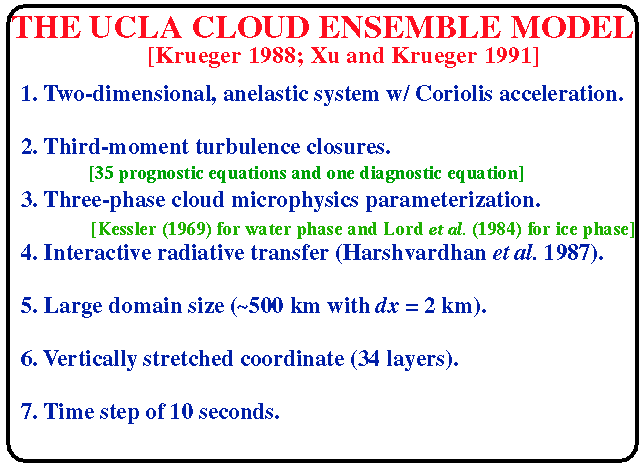
The UCLA cloud ensemble model was developed by S. K. Krueger in the early
1980s. It has been modified to include an interactive radiative transfer
parameterization at CSU (Xu and Randall 1995a). It also includes a modified
ice-phase microphysics parameterization (Krueger et al. 1995), a new
turbulence length scale formulation and many other minor modifications in the
past five years.
Krueger, S. K., 1988: Numerical simulation of tropical cumulus clouds
and their interaction with the subcloud layer. J. Atmos. Sci. ,
45 , 2221-2250.
Xu and Randall 1995a: Impact of interactive radiative transfer on the
macroscopic behavior of cumulus ensembles. Part I: Radiation parameterization
and sensitivity tests. J. Atmos. Sci. , 52 , 785-799.
Krueger, S. K., Q. Fu, K. N. Liou, and H.-N. Chin, 1995: Improvements of an
ice-phase microphysics parameterization for use in numerical simulations of
tropical convection. J. Appl. Metero. , 34 , 281-287.
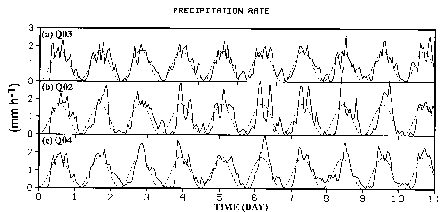
Time sequences of the hourly rate of entire domain-averaged surface
precipiration (solid) for Q02, Q03 and Q04 (see Xu, Arakawa and Krueger 1992).
As a reference, time sequence of the imposed large-scale advective effect is
shown with an arbitrarily chosen amplitude by the dashed line. The amplitude of
large-scale effect is identical in these three simulations. Q03 used a
non-sheared basic wind profile, but Q02 used a sheared basic wind profile. Both
of them used a horizontal domain size of 512 km. Q04 is identical to Q02 except
for a larger domain, 1024 km. In all these simulations, radiative heating rates
were prescribed.
Xu, Arakawa
and Krueger 1992: The mascroscopic behavior of cumulus ensembles simulated
by a cumulus ensemble model. J. Atmos. Sci. , 49 , 2402-2420.
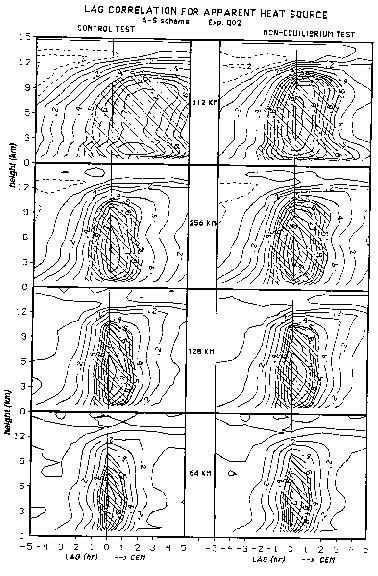
Lag correlation coefficients for apparent heat source as a function of
height for the 512-km (top panel), 256-km (second from top), 128-km (third from
top), and 64-km subdomains (bottom panel) of simulation Q02 (Xu, Arakawa and
Krueger 1992) from the control test (left column), i.e., with the standard
Arakawa-Schubert cumulus parameterization, and the nonequilibrium test (right
column), i.e., with the effect of the time change-rate of the cloud work
function. See Xu and Arakawa (1992) for details. Hatched areas correspond to
correlation coefficients greater than 0.5 with a contour interval of 0.05;
contour interval is 0.1 outside the hatched areas. A positive lag time
indicates that the parameterized cumulus convection precedes the simulated
cumulus convection.
Xu and
Arakawa 1992: Semi-prognostic tests of the Arakawa-Schubert cumulus
parameterization using simulated data. J. Atmos. Sci. , 49 ,
2421-2436.
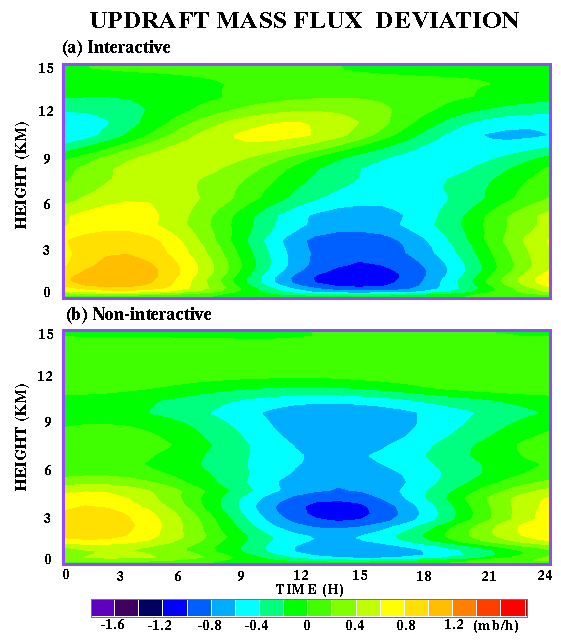
Time-height cross section of the ensemble mean of mass flux deviation in the
cloudy regions for (a) I05, a simulation with interactive radiation, and (b)
N05, a simulation with non-interactive radiation. The domain averaged radiative
heating rates are identical in both simulations. The contour interval is 0.2
mb/h. See Xu and Randall (1995) for details.
Xu and
Randall 1995: Impact of interactive radiative transfer on the macroscopic
behavior of cumulus ensembles. Part II: Mechanisms for cloud-radiation
interactions. J. Atmos. Sci. , 52 , 800-817.
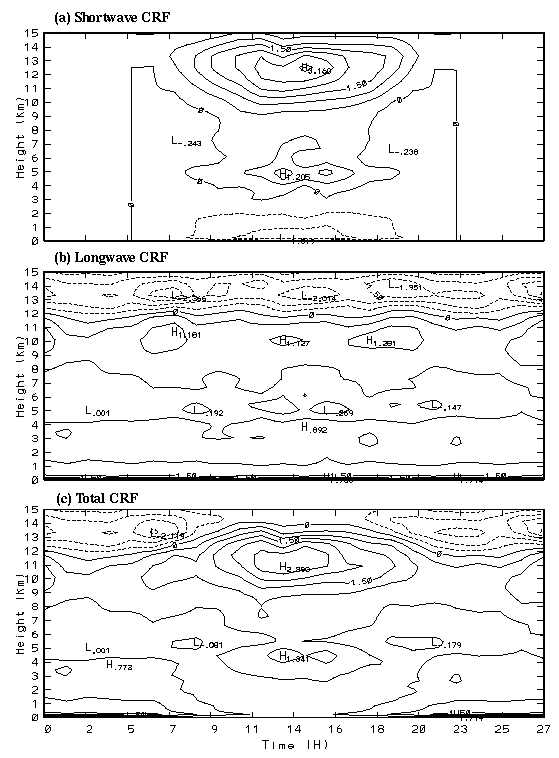
Time-height cross section of the ensemble mean of (a) shortwave cloud
radiative forcing (CRF), (b) longwave CRF, and (c) their sum for a simulation
with interactive radiation. The contour interval is 0.5 K/day. Contour over
0.5 K/day are hatched. See Xu and Randall (1995) for details.
Xu and
Randall 1995: Impact of interactive radiative transfer on the macroscopic
behavior of cumulus ensembles. Part II: Mechanisms for cloud-radiation
interactions. J. Atmos. Sci. , 52 , 800-817.
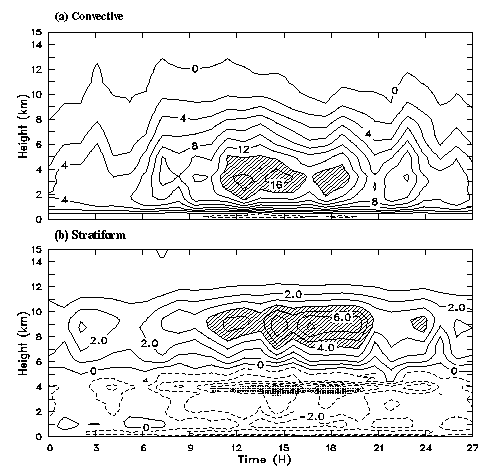
Time-height cross section of latent heat release in (a) convective region,
and (b) stratiform region of simulated cumulus ensembles. The contour interval
is 2 and 1 K/day in (a) and (b), respectively. Contours over 14 K/day and 4
K/day are hatched in (a) and (b), respectively. See Xu (1995) for details.
Xu 1995:
Partitioning mass, heat and moisture budgets of explicitly simulated cumulus
ensembles into convective and stratiform components. J. Atmos. Sci. ,
52 , 551-573.
Dept of Atmospheric Science
Colorado State University
(970)491-8591
kuanman.xu@atmos.colostate.edu
 General Circulation Model
General Circulation Model
 General Circulation Model
General Circulation Model











